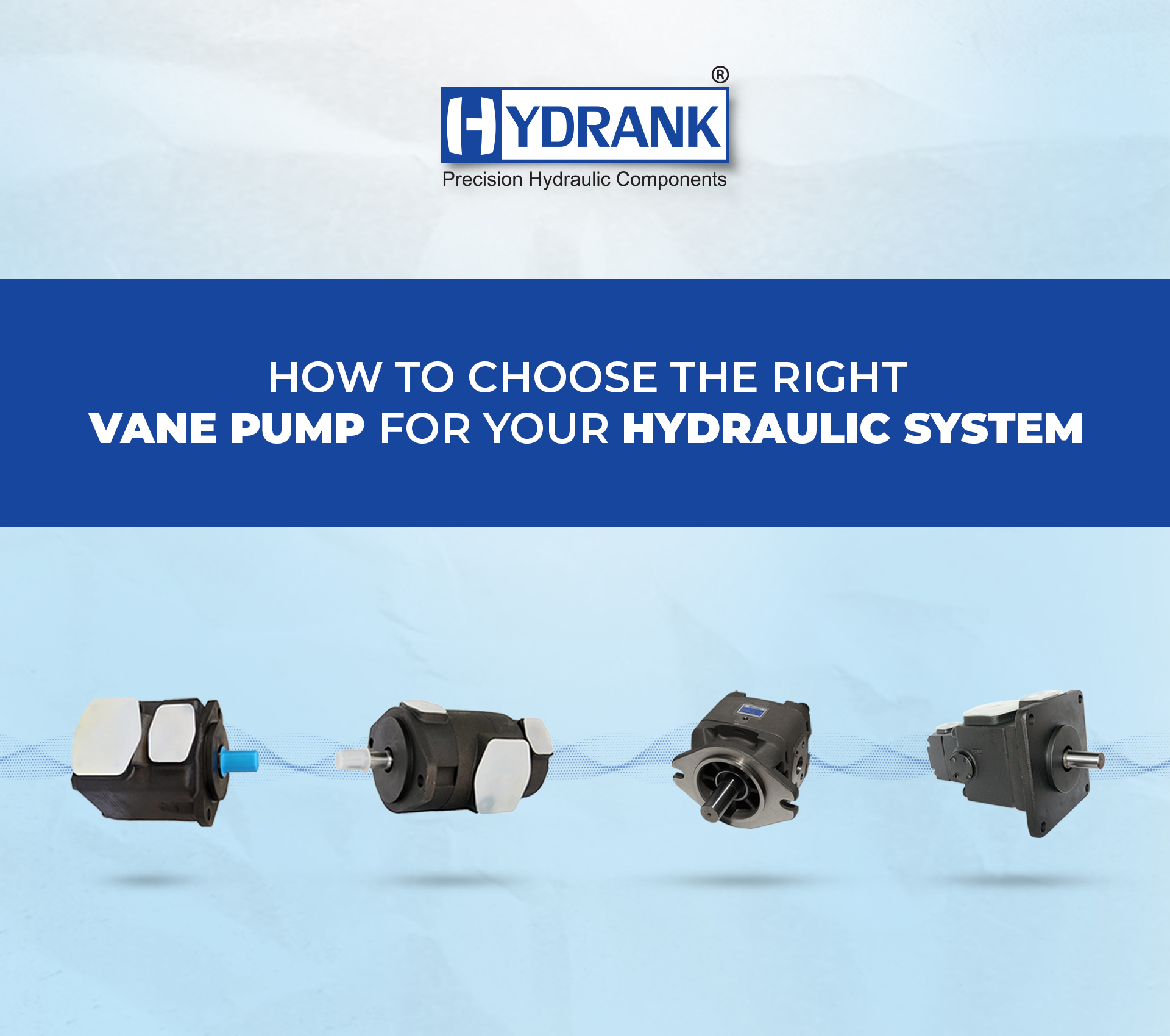-
How to Choose the Right Vane Pump for Your Hydraulic System?

In hydraulic engineering, selecting the right pump isn’t about brand preference; it’s about matching precision to performance. The vane pump, with its compact form, smooth flow, and quiet operation, has become a standard across industrial and mobile systems. But improper sizing or specification remains one of the main reasons hydraulic systems underperform.
This guide goes beyond generic advice. It focuses on engineering criteria, efficiency factors, and maintenance insights to help you make the right hydraulic vane pump selection — technically and economically.
1.Start with System Pressure, Not Displacement
Every vane pump operates within a defined pressure envelope. The first selection parameter should always be maximum working pressure, not displacement.
Operating a pump too close to its limit increases internal leakage, reduces volumetric efficiency, and accelerates wear on vanes and pressure plates.Engineering Rule:
Select a pump rated at least 15–20% above the system’s continuous operating pressure.
For instance, if your circuit operates at 160 bar, a 200–210 bar-rated pump provides optimal safety margin and mechanical stability.Pressure defines the pump’s mechanical robustness — displacement can be adjusted afterward to match flow requirements.
2.Choose Displacement Based on Flow Efficiency, Not Speed
Once the pressure range is known, define flow requirements based on actuator velocity and cycle time. Don’t default to higher displacement for “extra performance.”
Oversized pumps lead to wasted energy and thermal loading; undersized ones create cavitation and sluggish response.Calculation Tip:
Q=D×N1000Q = \frac{D \times N}{1000}Q=1000D×N
Where Q is flow (L/min), D is displacement (cc/rev), and N is speed (rpm).
A pump operating between 1200–1800 rpm generally delivers the best efficiency-to-noise ratio in industrial systems.
3.Understand Fixed vs. Variable Configuration
The choice between fixed and variable displacement is not about cost — it’s about duty cycle.
- Fixed displacement vane pumps are suited for steady-load systems: hydraulic presses, metal forming, and clamping units.
- Variable displacement vane pumps are essential in variable-load systems: injection moulding, CNC automation, or test benches.
- Variable versions regulate flow automatically based on pressure feedback, cutting power loss by up to 30% compared to constant-flow pumps. If your system experiences load fluctuations beyond ±15%, variable displacement is the technically correct choice.
4.Check Viscosity and Fluid Type — Real Efficiency Depends on It
Efficiency is not fixed; it’s fluid-dependent.
A vane pump performs best when fluid viscosity is between 25–60 cSt at operating temperature.
Below this range, internal leakage rises. Above it, vane tip lubrication drops, increasing wear.If your application uses fire-resistant or biodegradable fluids, confirm material compatibility. Pumps from Shriank, for example, offer optional seal kits (NBR, FKM, or PTFE) and shaft coatings to match different oil chemistries.
Never assume standard seals will withstand phosphate ester or water-glycol fluids — this single mistake causes more field failures than poor assembly.
5.Prioritize Efficiency Curves Over Catalogue Ratings
Most catalogues list “nominal efficiency.” What matters is efficiency at your pressure and speed.
High-quality vane pumps maintain volumetric efficiency of greater than 92% and mechanical efficiency of greater than 85% across their rated range.If performance curves flatten sharply above 80% of rated pressure, that pump will consume more power and generate unnecessary heat in real operation.
Always request full efficiency data before selection, not just theoretical specifications.6.Noise and Vibration Are Mechanical Quality Indicators
Noise levels reveal how precisely a pump is machined.
A 2–3 dB difference can indicate inferior internal balancing or poor vane surface finishing.Look for:
- Radial balance design: eliminates side loading on the rotor.
- Dynamic pressure plate compensation: maintains sealing across temperature variations.
- Tight geometric tolerances (≤5 μm): critical for smooth vane motion and flow consistency.
7.Think Maintenance Before Installation
In practical hydraulics, maintainability is performance. A pump that’s easy to service stays efficient longer.
The best vane pumps feature cartridge-style assemblies, allowing replacement of the rotor, vanes, and side plates without disturbing plumbing or alignment.In hydraulic pump maintenance, downtime cost often exceeds component cost. Shriank’s modular cartridge design reduces service time from hours to minutes a factor often overlooked during initial selection.
8.Match the Pump to the System Environment
Ambient conditions directly affect vane pump performance:
- High-temperature systems (>70°C): require thermally stabilized seals and precision end-plate clearance.
- Outdoor or mobile applications: demand corrosion-resistant housings and reinforced shaft seals.
- Vertical installations: must include positive priming and air-bleed ports to avoid dry starts.
9.Evaluate Supplier Engineering Depth, Not Catalogue Breadth
In hydraulic components, brand alone doesn’t ensure reliability; engineering support does.
A competent manufacturer like Shriank provides more than part numbers:- Flow-pressure test certificates for every pump.
- Application-specific recommendations for displacement, viscosity, and drive configuration.
- Spare kits and technical documentation for preventive maintenance.
10.Always Balance Performance with Lifecycle Economics
Selecting the “right” pump isn’t about the lowest price; it’s about the lowest cost per operating hour.
An efficient, properly sized vane pump consumes less energy, needs fewer repairs, and maintains consistent flow for years.A slightly higher upfront investment in a precision-engineered unit like a Shriank vane pump results in:
- Lower thermal losses
- Longer service intervals
- Predictable maintenance cycles
- Higher overall system reliability
Conclusion: Precision Selection Defines Performance
The vane pump remains one of the most efficient and serviceable hydraulic technologies available, but only when selected using engineering logic, not assumptions.
Correct hydraulic vane pump selection means understanding pressure, flow, efficiency curves, and service conditions, not just matching displacement numbers.
With its focus on mechanical precision, modular design, and application-specific customization, Shriank continues to provide vane pumps that combine energy efficiency with long service life.A well-chosen pump isn’t just a component — it’s the foundation of system stability, energy economy, and long-term reliability.
India's Largest Hydraulic Vane Pump Supplier
contact us: +91 98980 09148
Delivery
Prompt and accurate delivery
Client Servicing
Pro after-sales customer support
Quality assurance
Top quality standards
Export
More then 10 countries
